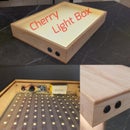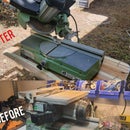Introduction: Floating Shelf With Mountains
After my newly discovered extraordinary woodworking skills, my wife had a new request:
A floating shelf with mountains on top.
Now, a floating shelf is clear, I've seen them and I love them for the aesthetics and simplicity.
But mountains?
Apparently it is a new fashion in house interior design, just google: "shelf with mountains" and you will get the idea :)
Personally, it is wasted on me, but I love challenges and I love my wife.
And, I'm happy to inform, that she loved the outcome.
So, here it is, hope you like it.
Step 1: Design and Preliminaries
The first thing is to translate the directions into something tangible.
So, from "can you build me a shelf with mountains?" we will translate it into dimensions, layout and general picture of the outcome.
So we did.
I did it with Fusion360 and the layout is attached. Note that dimensions are in [mm].
The important thing is getting this approved by the higher authority :) and the tiny details can be figured later on.
Next thing is to understand how floating shelves are made.
There are tons of YouTube videos, and I liked this one:
I will be following the mounting system covered in it, with the added mountains on top.
The shelf will be made out of oak boards 6" width and 3/4" thick (~20mm).
Other stuff to complete your build:
1. Oak dowel 1/2".
2. Wood glue
3. Sandpaper
4. Wood bolts
5. Hardware to attach things to your walls.
I sourced everything from Home Depot.
Finally, the tools you will need:
1. Miter saw.
2. Circular saw/Table saw
3. Drill
4. Sander
5. Planer
Step 2: Cut Your Wood and Do a Test Fit
Although I'm referencing my dimensions and design, you can really adapt it as you wish.
The instructable is meant to be general.
Look again at your design dimensions and cut the lengths out of your freshly acquired boards.
I used a miter saw for that.
One thing to consider, add up the dimensions and see what is the result. I had to go twice to the store because I underestimated all the material that is needed.
Once everything is cut, it is always a good idea to do a sanity check and put everything together.
The masking tape works wonders for this.
Step 3: Prep Your Base
Take your base board and sand it and make sure it is what you like it to be.
Because the purchased boards were already nice, I just used a 180 grit sandpaper with my sander, and it worked out lovely.
Next we would like to locate 3 places where the 1/2" dowels will come in. These are holding the weight of the entire structure. I spaced them uniformly.
Drill the 1/2" holes through the width of the board, not until the very end. I left around 3/4" to the tip.
Now, and this is where the table saw becomes handy, cut 1.25" width lengthwise of the board.
This can also be done (carefully) with a circular handheld saw with proper fence.
Now, the thinner strip will be mounted to the wall, and the shelf will slide in on the dowels.
Next, prep the dowels.
You can notice these are not coming in easily, although the dowels and the holes are 1/2".
Cool method I learned from the video: chuck them in the drill and run the sandpaper while you run it.
Note the 1.25" part should fit snug into the wood, and the rest of the dowel's length should fit more loosely through the shelf (not too loose though).
Do frequent stops and constantly check the fit of the dowels through the wood.
Once everything fits and you are happy, glue the dowels into the thin strip.
Step 4: Do the First Mountain
Starting with the right mountain, the one that is symmetric.
Have not done this previously, but trying to do a neat work here.
I taped a lengths template on the table and traced the resulting cuts after dry fit.
Having only 10" miter saw at hand, I did some adjustments as you can see.
It could not cut the steep angles with the built in tilt, so I needed to adjust with wooden blocks.
It was fun and definitely rewarding. (Maybe not very safe...)
Having clamps here is a good idea, as the whole thing is shifting in the process.
I did the initial cuts with the miter saw, and had to hand saw a small tip, again due to the limited size of the miter saw.
It is a small adjustment, but it can be annoying, as I spliced one of the tips.
Wooden glue and overnight dry solved the problem.
Once everything fits, align the two sides on a piece of plywood with small blocks.
Apply glue and let dry for the night.
Step 5: Attach the Mountain to the Base
Note that you are attaching it only to the wider strip (and not the one with the dowels)
Align the base with the mountain.
Sand the angles slightly if needed.
Make sure everything is clamped, drill and run the bolts through.
Each side gets two bolts.
Don't worry now for the slight misfits on the edges, we will take care of this later.
Later we will add glue in between.
Step 6: Add the Second Mountain
The second one repeats the familiar process.
Cut the miters.
Glue the two pieces.
Adjust the slope cuts, and glue to the existing mountain.
I have to admit this process took some time, because I misaligned the angles at first.
After much of cutting and sanding, the outcome was good enough to glue the two mountains together.
Once the glue is dry, attach the two summits with wooden bolts.
Do the pose shot for approval :)
Step 7: Final Cosmetic Touches
Slight misalignments are expected.
Mine was with the mountains protrude slightly over the base.
It should also be expected, due to the reduced width of the base due to saw "kerf".
My way of dealing with it was planning it almost flush and then sanding the whole edge with 180 grit.
I'm happy to report that the final outcome is smooth and almost professional looking.
Step 8: Final Touches
Adding the hardware holes to attach it to the wall.
I used 4 bolts. Make sure the head is recessed inside to make the two base pieces flush with each other while assembled.
Go on and do the final sanding of the whole thing.
Final thing is the wood conditioning.
It protects the wood and makes the whole thing appear nicer. All the grain is also shows and I love it.
My go to wood conditioner is: Howard Butcher Block Conditioner.
And of course it is the one that my wife chose:
Step 9: Mounting
This is straightforward.
Use level and appropriate hardware for your wall.
Mount the smaller piece of the base.
Slide on the whole thing on the dowels.
You are done!













